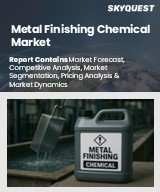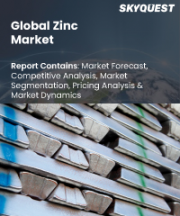
|
시장보고서
상품코드
1329007
세계의 탄산아연 시장 평가 : 유래별, 유형별, 최종 이용 산업별, 지역별, 기회, 예측(2016-2030년)Zinc Carbonate Market Assessment, By Origin, By Type, By End-use Industry, By Region, Opportunities, and Forecast, 2016-2030F |
||||||
세계의 탄산아연(Zinc Carbonate) 시장 규모는 2022년 6억 684만 달러에 달했습니다. 2030년 8억 6,365만 달러에 이를 전망이며, 2023년부터 2030년까지 4.51%의 CAGR 성장이 예측됩니다.
비료의 높은 수요
세계의 인구가 증가함에 따라 식량 요구가 커지고 있으며 농업 탄산아연 수요를 촉진하고 있습니다.
예를 들어 인도에서 가장 많이 소비되는 미량 영양소는 아연으로 미량 영양소 비료 소비의 전체 59.0%를 차지하고 있습니다. 인도 농경지의 아연 부족 만연이 그 이유입니다. 게다가 몇몇 기타 국가들 농경지는 아연이 크게 부족하여 세계의 미량 영양소로서 탄산아연 수요가 증가하고 있습니다.
아시아태평양 의약품 강력한 성과
소비자 건강과 웰빙 의식 증가는 아연을 포함한 의약품과 영양 보충제 수요에 영향을 미치고 있습니다.
인도는 제약 업계 최전선 중 하나이며 탄산아연은 방부제 및 피부 보호제와 같은 의약품에 주로 사용되는 원료 중 하나입니다. 2022년 인도 제약산업은 대량 제조 가치제공으로 변혁해 전년대비 8% 증가한 219억 9,000만 달러라는 경이적인 숫자에 이르렀습니다. 특히 인도와 중국과 같은 아시아태평양 국가는 이러한 의약품 제조 증가가 탄산아연 수요 증가에 기여하고 있습니다.
자동차 부문 성장
자동차 및 운송 부문 확대나 소비자 제품 수요가 고무 제품 시장에 영향을 주고, 그것이 탄산아연 수요에도 영향을 줍니다.
2022년 말까지 인도에서만 약 370만 대의 승용차가 생산되었으며, 2022년 세계의 승용차 판매량이 증가했습니다. 2022년 전기차 판매량은 1,020만대 이상으로 전년대비 65% 증가했습니다. 이와 같이 자동차 판매량 증가는 고무품 수요 증가를 나타내며 탄산아연 수요를 견인하고 있습니다.
COVID-19 영향
COVID-19 발생은 공급망 혼란, 생산 정지, 제조 활동 중단을 일으켰고, 이들 모두가 2020년 시장에 악영향을 주었습니다. 락다운은 비료, 석유 및 가스 및 기타 많은 최종 이용 산업 수요를 줄이거나 완전히 잃었습니다. COVID-19는 미용 산업 시장 약 30%가 폐쇄되었기 때문에 고급 미용 제품 판매점 폐쇄로 이어지고 있습니다. L"Oreal 연례 보고서에 따르면 탄산아연 주요 최종 사용자, 부문 중 하나인 화장품을 포함한 세계의 미용 제품 수요가 8% 감소했기 때문에 COVID-19는 세계의 탄산아연 시장 수요를 아래로 내렸습니다.
러시아 우크라이나 전쟁 영향
러시아, 우크라이나 전쟁 영향으로 비료, 석유, 가스 등 여러 필수품에 영향을 미쳤습니다. 전쟁으로 인한 공급망 혼란은 운송비 인상, 컨테이너 부족, 창고 공간 감소로 이어집니다. 일부 항구는 폐쇄되었고 배송 지연과 혼잡으로 인해 주문이 되돌려졌습니다. 흑해 항구는 몇몇별 노선과 더불어 운영할 수 없게 되고, 몇몇 제품 및 상품공급 정지로 이어지고 있습니다. 우크라이나와 러시아는 모두 금속 및 광물 주요 수출국이었지만, 이들 국가 수출이 분쟁 진행에 의해 영향을 받기 때문에 일부 수입국 탄산아연 공급 시나리오에 영향을 주었습니다. 전쟁은 우크라이나 밀 재배 능력에 영향을 미치고 우크라이나는 주요 밀 수출국이기 때문에 기타 국가들은 세계의 수요를 충족시키기 위해 밀 재배를 늘려야 하며, 그 결과 이들 국가 비료로서 탄산아연 수요가 증가했습니다.
세계의 탄산아연(Zinc Carbonate) 시장 조사 분석을 통해 시장 규모와 예측, 시장 역학, 주요 기업 현황과 전망 등을 제공합니다.
목차
제1장 조사 방법
제2장 프로젝트 범위와 정의
제3장 탄산아연 시장 COVID-19 영향
제4장 러시아, 우크라이나 전쟁 영향
제5장 주요 요약
제6장 고객 의견
- 시장 인지도와 제품 정보
- 브랜드 인지도와 충성도
- 구매 결정 고려되는 요소
- 구매 빈도
- 구입 매체
제7장 탄산아연 시장 전망(2016-2030년)
- 시장 규모와 예측
- 금액
- 수량
- 유래별
- 스파레라이트
- 진사이트
- 스미소나이트
- 윌레마이트
- 헤미몰파이트
- 기타
- 유형별
- 화학 등급
- 의료 등급
- 최종 이용 산업별
- 의약품
- 화장품, 퍼스널케어
- 고무 산업
- 비료
- 석유 및 가스
- 기타
- 지역별
- 북미
- 유럽
- 남미
- 아시아태평양
- 중동 및 아프리카
제8장 탄산아연 시장 전망 : 지역별(2016-2030년)
- 북미
- 미국
- 캐나다
- 멕시코
- 유럽
- 독일
- 프랑스
- 이탈리아
- 영국
- 러시아
- 네덜란드
- 스페인
- 터키
- 폴란드
- 남미
- 브라질
- 아르헨티나
- 아시아태평양
- 인도
- 중국
- 일본
- 호주
- 베트남
- 한국
- 인도네시아
- 필리핀
- 중동 및 아프리카
- 사우디아라비아
- 아랍에미리트(UAE)
- 남아프리카
제9장 공급측 분석
- 생산 능력 : 기업별
- 생산 : 기업별
- 가동 효율 : 기업별
- 주요 공장 소재지(최대 25)
제10장 시장 매핑(2022년)
- 유래별
- 유형별
- 최종 이용 산업별
- 지역별
제11장 거시적 환경과 산업 구조
- 수급 분석
- 수출입 분석-수량과 금액
- 공급/가치 체인 분석
- PESTEL 분석
- 포터의 5세력 분석
제12장 시장 역학
- 성장 촉진 요인
- 성장 억제 요인(과제, 성장 억제 요인)
제13장 주요 기업 정세
- 마켓 리더 상위 5개사 경쟁 매트릭스
- 마켓 리더 주요 5개사 시장 수익 분석(2022년)
- 합병과 인수/합작사업(해당하는 경우)
- SWOT 분석(시장 참가 기업 5사용)
- 특허 분석(해당하는 경우)
제14장 가격 분석
제15장 사례 연구
제16장 주요 기업 전망
- L. Bruggemann Gb& Co. KG
- The Norkem Group
- Shepherd Chemical Company
- Seido Chemical Industry Co., Ltd
- Pan-Continental Chemical Co.Ltd
- US Zinc Corporation
- AVA Chemicals Private Limited
- Anron Chemicals Co
- ABCR GmbH& CO. KG
- Advance Inorganics.
제17장 전략 권장 사항
제18장 당사에 관하여, 면책 사항
NJH 23.08.24Zinc carbonate's world market size was valued at USD 606.84 million in 2022, which is expected to grow to USD 863.65 million in 2030 with a CAGR of 4.51% during the forecast period between 2023 and 2030. A significant market growth factor for zinc carbonate is agriculture. Micronutrient zinc is crucial for the growth and development of plants. In agriculture, zinc carbonate is frequently used as a zinc fertilizer, particularly in soils with zinc deficiencies. The demand for food and the need for zinc carbonate in agriculture are expected to grow as the world's population expands.
Additionally, the pharmaceutical industry also has a big impact on the market for zinc carbonate in addition to these other drivers. Zinc carbonate is used as a source of zinc in pharmaceuticals and dietary supplements. Zinc is a trace element that is crucial for the human body. The demand for pharmaceuticals and supplements containing zinc is anticipated to increase as health and wellness awareness rises, which will have an impact on the market for zinc carbonate. Moreover, ZnC is extensively used in the manufacturing of rubber goods such as tires, conveyor belts, and footwear among others. The demand for zinc carbonate is anticipated to grow steadily due to the expansion of the automotive and transportation sectors along with the rise in consumer demands for long-lasting and high-quality rubber products.
High Demand for Fertilizer
Micronutrient zinc is crucial for the growth and development of plants. In agricultural applications, zinc carbonate is used as a zinc fertilizer, particularly in soils with zinc deficiencies. The need for food is increasing along with the world population growth, which is what is driving the demand for zinc carbonate in agriculture.
For instance, the most consumed micronutrient in India is zinc, which makes up 59.0% of all micronutrient fertilizer consumption. The widespread zinc deficiency in agricultural soils in India explains this portion. Additionally, agricultural soil in several other countries is also highly deficient in zinc, increasing the demand for zinc carbonate as a global micro-nutrient.
Strong Performance of Pharmaceuticals in Asia-Pacific
Zinc is an element that is essential to human health and is important for many biological processes. Pharmaceuticals and dietary supplements both use zinc carbonate as a source of zinc. Consumers' increasing health and wellness consciousness influences the demand for pharmaceuticals and dietary supplements containing zinc.
India is one of the leading forefronts in the pharmaceutical industry and zinc carbonate is one of the raw materials majorly used in pharmaceuticals such as an antiseptic and skin protectant. In 2022 the pharmaceutical industry in India transformed from a volume creator to a value provider and witnessed year on year growth by 8% reaching a staggering figure of USD 21.99 billion in 2022. This level of rise in pharma manufacturing especially in Asia-Pacific countries like India and China contributes to the growing demand for zinc carbonate.
Rising Automotive Sector
Zinc carbonate is a crucial component in creating rubber goods like tires, conveyor belts, and footwear. The expansion of the automotive and transportation sectors, as well as consumer product demand, impacts the rubber goods market, which in turn influences zinc carbonate demand.
At the end of fiscal year 2022, approximately 3.7 million passenger vehicles were produced across India alone and moreover, the global passenger vehicles produced in 2022 the passenger vehicles sale witnessed rise. The volume of electric vehicles sold during 2022 was over 10.2 million units which is a 65% year on year growth. Thus, the rise in sales of automotive indicates an increase in demand for rubber goods, which drives the demand for zinc carbonate.
Impact of COVID-19
COVID-19 outbreak caused supply chain disruptions, production halts and manufacturing activity interruptions, all of which had a detrimental effect on the zinc carbonate market in 2020. The lockdown decreased demand or complete loss from several end-user industries such as fertilizers, oil and gas and many others. COVID- 19 led to the closure of premium beauty products outlets as approximately 30% of the beauty industry market was shut down. The annual report of L'Oreal indicates an 8% decline in the demand for global beauty products which includes cosmetics and cosmetics in one of the major end user segments for the zinc carbonate therefore COVID-19 bought down the demand of the zinc carbonate market globally.
Impact of Russia-Ukraine War
The impact of Russia-Ukraine war had led to a in several commodities such as fertilizers, and oil and gas. The supply chain disruptions which came into effect due to the war led to an increase in freight charges, created container shortages, and decreased warehousing space. Several of the ports were closed and orders pulled back due to delays in shipments and congestion. The black seaport coupled with several other routes became non-operational leading to a cease in the supply of several products and commodities. Both Ukraine and Russia were key exports of metals and minerals, since the export of these countries as been impacted by the ongoing conflict, it affected the supply scenario of zinc carbonate in several importing countries. Since the war had an impact on Ukraine's ability to grow wheat and Ukraine being the major wheat exporting country, other nations had to increase their wheat cultivation to meet the global demand, which increased the demand for zinc carbonate as fertilizer in those countries.
Key Players Landscape and Outlook
Major market players for zinc carbonate are actively pursuing strategic acquisitions to improve their competitiveness and increase their market share. With these acquisitions, companies hope to expand their product lines, gain access to cutting-edge technologies and resources, expand into new markets, and gain a competitive edge. For Instance, in June 2022, EverZinc, a portfolio company of OpenGate Capital, was acquired by U.S. Zinc (Aterian Investment Partners) which would help U.S.Zinc to become world's largest zinc specialty chemical company.
Various developments influence the zinc carbonate market, which is significantly driving the market. The demand for zinc-coated steel is anticipated to continue to grow, supporting the galvanizing industry. This is due to the continued growth of the construction and infrastructure sectors. Additionally, the demand for rubber goods and zinc coatings will likely increase due to the automotive industry's consistent growth, particularly in emerging markets. In addition, the agricultural industry's emphasis on increasing crop yields and food production may encourage more people to use zinc carbonate as a zinc fertilizer. Technological developments in manufacturing processes might further optimize its applications, opening up new market opportunities. However, environmental regulations and shifting consumer preferences toward sustainable and eco-friendly alternatives may also impact the market's future course.
Table of Contents
1. Research Methodology
2. Project Scope & Definitions
3. Impact of COVID-19 on Zinc Carbonate Market
4. Impact of Russia-Ukraine War
5. Executive Summary
6. Voice of Customer
- 6.1. Market Awareness and Product Information
- 6.2. Brand Awareness and Loyalty
- 6.3. Factors Considered in Purchase Decision
- 6.3.1. Brand Name
- 6.3.2. Quality
- 6.3.3. Quantity
- 6.3.4. Price
- 6.3.5. Product Specification
- 6.3.6. Application Specification
- 6.3.7. VOC/Toxicity Content
- 6.3.8. Availability of Product
- 6.4. Frequency of Purchase
- 6.5. Medium of Purchase
7. Zinc Carbonate Market Outlook, 2016-2030F
- 7.1. Market Size & Forecast
- 7.1.1. By Value
- 7.1.2. By Volume
- 7.2. By Origin
- 7.2.1. Sphalerite
- 7.2.2. Zincite
- 7.2.3. Smithsonite
- 7.2.4. Willemite
- 7.2.5. Hemimorphite
- 7.2.6. Others
- 7.3. By Type
- 7.3.1. Chemical Grade
- 7.3.2. Medical Grade
- 7.4. By End-use Industry
- 7.4.1. Pharmaceuticals
- 7.4.2. Cosmetics and Personal Care
- 7.4.3. Rubber Industry
- 7.4.4. Fertilizers
- 7.4.5. Oil and Gas
- 7.4.6. Others
- 7.5. By Region
- 7.5.1. North America
- 7.5.2. Europe
- 7.5.3. South America
- 7.5.4. Asia-Pacific
- 7.5.5. Middle East and Africa
8. Zinc Carbonate Market Outlook, By Region, 2016-2030F
- 8.1. North America*
- 8.1.1. By Origin
- 8.1.1.1. Sphalerite
- 8.1.1.2. Zincite
- 8.1.1.3. Smithsonite
- 8.1.1.4. Willemite
- 8.1.1.5. Hemimorphite
- 8.1.1.6. Others
- 8.1.2. By Type
- 8.1.2.1. Chemical Grade
- 8.1.2.2. Medical Grade
- 8.1.3. By End-use Industry
- 8.1.3.1. Pharmaceuticals
- 8.1.3.2. Cosmetics and Personal Care
- 8.1.3.3. Rubber Industry
- 8.1.3.4. Fertilizers
- 8.1.3.5. Oil and Gas
- 8.1.3.6. Others
- 8.1.4. United States*
- 8.1.4.1. By Origin
- 8.1.4.1.1. Sphalerite
- 8.1.4.1.2. Zincite
- 8.1.4.1.3. Smithsonite
- 8.1.4.1.4. Willemite
- 8.1.4.1.5. Hemimorphite
- 8.1.4.1.6. Others
- 8.1.4.2. By Type
- 8.1.4.2.1. Chemical Grade
- 8.1.4.2.2. Medical Grade
- 8.1.4.3. By End-use Industry
- 8.1.4.3.1. Pharmaceuticals
- 8.1.4.3.2. Cosmetics and Personal Care
- 8.1.4.3.3. Rubber Industry
- 8.1.4.3.4. Fertilizers
- 8.1.4.3.5. Oil and Gas
- 8.1.4.3.6. Others
- 8.1.5. Canada
- 8.1.6. Mexico
- 8.1.1. By Origin
All segments will be provided for all regions and countries covered
- 8.2. Europe
- 8.2.1. Germany
- 8.2.2. France
- 8.2.3. Italy
- 8.2.4. United Kingdom
- 8.2.5. Russia
- 8.2.6. Netherlands
- 8.2.7. Spain
- 8.2.8. Turkey
- 8.2.9. Poland
- 8.3. South America
- 8.3.1. Brazil
- 8.3.2. Argentina
- 8.4. Asia-Pacific
- 8.4.1. India
- 8.4.2. China
- 8.4.3. Japan
- 8.4.4. Australia
- 8.4.5. Vietnam
- 8.4.6. South Korea
- 8.4.7. Indonesia
- 8.4.8. Philippines
- 8.5. Middle East & Africa
- 8.5.1. Saudi Arabia
- 8.5.2. UAE
- 8.5.3. South Africa
9. Supply Side Analysis
- 9.1. Capacity, By Company
- 9.2. Production, By Company
- 9.3. Operating Efficiency, By Company
- 9.4. Key Plant Locations (Up to 25)
10. Market Mapping, 2022
- 10.1. By Origin
- 10.2. By Type
- 10.3. By End-use Industry
- 10.4. By Region
11. Macro Environment and Industry Structure
- 11.1. Supply Demand Analysis
- 11.2. Import Export Analysis - Volume and Value
- 11.3. Supply/Value Chain Analysis
- 11.4. PESTEL Analysis
- 11.4.1. Political Factors
- 11.4.2. Economic System
- 11.4.3. Social Implications
- 11.4.4. Technological Advancements
- 11.4.5. Environmental Impacts
- 11.4.6. Legal Compliances and Regulatory Policies (Statutory Bodies Included)
- 11.5. Porter's Five Forces Analysis
- 11.5.1. Supplier Power
- 11.5.2. Buyer Power
- 11.5.3. Substitution Threat
- 11.5.4. Threat from New Entrant
- 11.5.5. Competitive Rivalry
12. Market Dynamics
- 12.1. Growth Drivers
- 12.2. Growth Inhibitors (Challenges, Restraints)
13. Key Players Landscape
- 13.1. Competition Matrix of Top Five Market Leaders
- 13.2. Market Revenue Analysis of Top Five Market Leaders (in %, 2022)
- 13.3. Mergers and Acquisitions/Joint Ventures (If Applicable)
- 13.4. SWOT Analysis (For Five Market Players)
- 13.5. Patent Analysis (If Applicable)
14. Pricing Analysis
15. Case Studies
16. Key Players Outlook
- 16.1. L. Bruggemann Gb & Co. KG
- 16.1.1. Company Details
- 16.1.2. Key Management Personnel
- 16.1.3. Products & Services
- 16.1.4. Financials (As reported)
- 16.1.5. Key Market Focus & Geographical Presence
- 16.1.6. Recent Developments
- 16.2. The Norkem Group
- 16.3. Shepherd Chemical Company
- 16.4. Seido Chemical Industry Co., Ltd
- 16.5. Pan-Continental Chemical Co.Ltd
- 16.6. US Zinc Corporation
- 16.7. AVA Chemicals Private Limited
- 16.8. Anron Chemicals Co
- 16.9. ABCR GmbH & CO. KG
- 16.10. Advance Inorganics.
Companies mentioned above DO NOT hold any order as per market share and can be changed as per information available during research work.



















